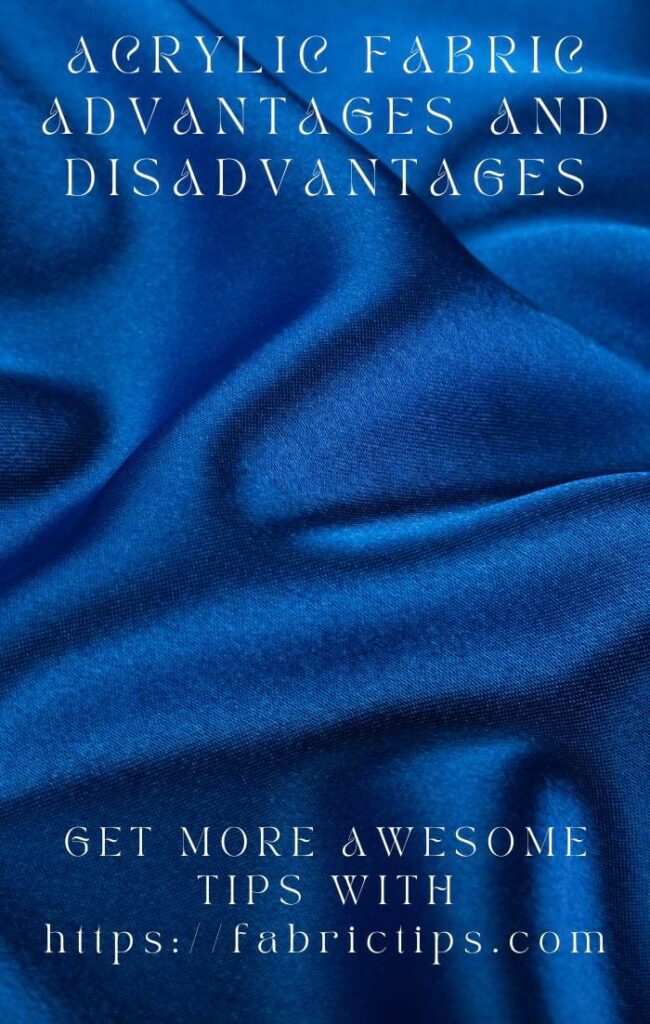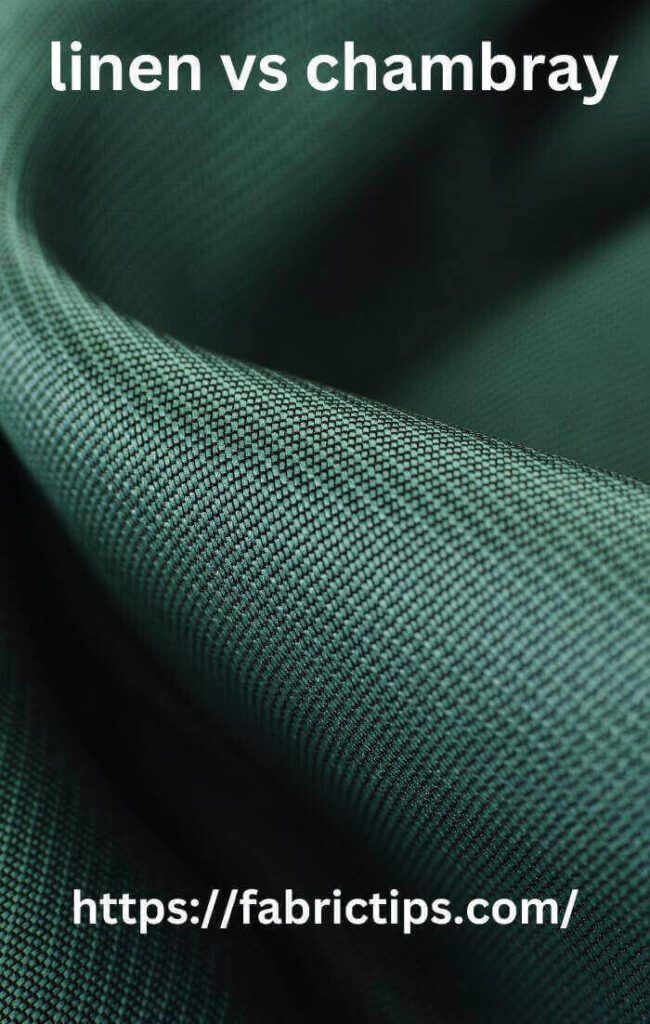Last Updated on December 13, 2025 by Wahid
The sofa you choose should be comfortable, luxurious, & easy to maintain. Well, whether you plan to cover your beloved chair, couch, or even a headboard, you’ll need a material that feels soft and moves easily.
Your supplier now offers a wide range of upholstery materials that are instantly well-suited for your project. But confusing, which is better: Chenille Vs Velvet? Which one should I choose? You can find out the answers by reading below.
Chenille Vs Velvet: Comparison Chart
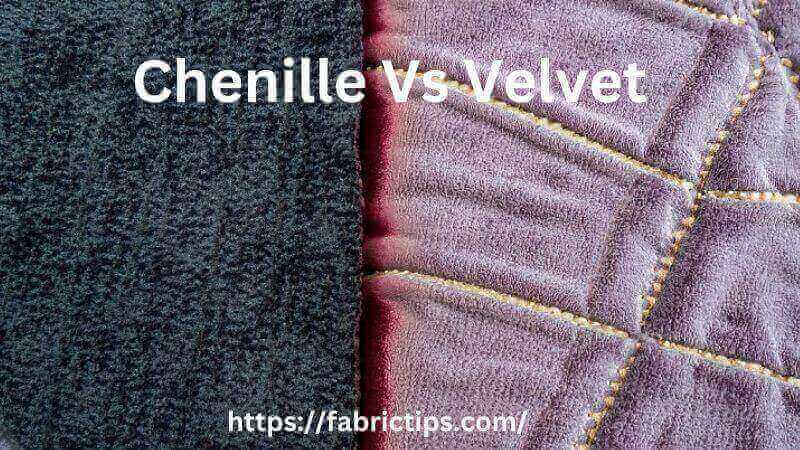
Chenille or Velvet, how do they differ from one another? You can learn how to distinguish chenille from velvet below the comparison list so that you are able to make the most informed choice for your upcoming project.
| Criteria | Chenille | Velvet |
| Definition: | Chenille is a type of yarn with a velvety texture that is made by twisting together short lengths of yarn around a core yarn. | Velvet is a luxurious fabric with a soft, plush pile that is made by weaving two layers of cloth together and then cutting the pile. |
| Material: | Cotton, rayon, acrylic, and polyester are all common materials used to make Chenille yarn. | Textiles made from velvet are traditionally made of silk, but they may also be made of cotton, wool, & synthetic fibers. |
| Texture: | Chenille has a soft, plush texture that resembles a caterpillar. | Velvet has a smooth, dense texture that is soft and luxurious to the touch. |
| Durability: | Chenille is less durable than velvet and tends to wear and tear easily. | Velvet is more durable than chenille and can withstand wear and tear better. |
| Maintenance: | Snagging and shedding make Chenille more maintenance-intensive. Spot cleaning is recommended rather than frequent washing. | A velvet couch can be dry-cleaned or hand-washed, making it easier to maintain. |
| Uses: | Chenille is commonly used for upholstery, blankets, and pillows. | Velvet is used for clothing, furniture upholstery, and home decor items like curtains & drapes. |
| Cost: | Generally, chenille is cheaper than velvet due to its materials. | The luxurious appearance and materials used in velvet make it more expensive than chenille. |
| Color Retention: | Chenille has a tendency to fade over time & lose its color. | Velvet tends to retain its color & appearance over time. |
| Warmth: | Compared to velvet, Chenille has a plusher texture that makes it a warmer fabric. | A Velvet’s dense texture makes it less warming than a chenille. |
| Allergies & Asthma: | Chenille is a great breeding ground for dust mites, which is why it is not a good choice if you suffer from allergies or asthma. | Velvet is hypoallergenic, making it a good choice for allergy and asthma sufferers. |
As a whole, Chenille and Velvet are popular fabrics because of their softness and luxurious appearance. However, they differ for a number of reasons, including durability, maintenance, degree of warmth, as well as allergy and asthma concerns. Ultimately, choosing between velvet and chenille depends on personal preferences and how the fabric will be used.
Attention & Precaution: Caring For Chenille and Velvet
Care Instructions For Chenille Fabric
- Routine Cleaning: Emphasize the importance of regular, gentle cleaning for chenille to maintain its appearance and texture. This segment will offer practical advice on vacuuming and light dusting techniques, vital in the “Chenille Vs Velvet” comparison.
- Spot Cleaning & Stain Removal: Provide step-by-step guidance on how to handle spills and stains on chenille fabric, using mild detergents and avoiding harsh chemicals to preserve the fabric’s integrity.
- Professional Care: Recommend periodic professional cleaning for chenille items, especially those used frequently, to ensure longevity and maintain quality.
Maintenance Tips For Velvet
- Handling Velvet With Care: Detail the specific needs of velvet fabric in terms of handling and cleaning, acknowledging its delicate nature in contrast to chenille in the broader “Chenille Vs Velvet” context.
- Avoiding Crush Marks & Creases: Offer tips on how to prevent and remove crush marks and creases from velvet, an important consideration for maintaining its luxurious appearance.
- Storage & Preservation: Advice on the best ways to store velvet items, including the use of garment bags and avoiding prolonged exposure to direct sunlight.
Prolonging The Life Of Each Fabric
- Regular Maintenance Routines: Highlight the importance of consistent care routines for both chenille and velvet, tailoring the advice to the specific needs of each fabric within the “Chenille Vs Velvet” narrative.
- Appropriate Usage & Handling: Discuss how proper usage and handling can significantly extend the life of both chenille and velvet, including advice on avoiding excessive wear and tear.
- Professional Consultation: Encourage seeking professional advice for any significant concerns regarding chenille and velvet care, ensuring the fabrics remain in the best possible condition.
However, sum up the key points on caring for chenille and velvet, reinforcing the idea that proper attention and precaution can greatly enhance the life and appearance of these fabrics.
Chenille Vs Velvet: In-Depth Overviews
As you can see in the chart above, both Velvet vs Chenille fabric overviews are familiar to you. The following analysis will provide you with a deeper understanding. Let’s take a look.
What Is Chenille?

Chenille is a very soft, feathery fabric with a raised pattern. During the 18th century, France is believed to have invented it. Chenille is actually the French word for “caterpillar.” Back then, it was made by twisting warp lines around weft lines, then cutting them into strips. Cotton, silk, rayon, viscose, and a blend of natural and synthetic materials can all be used to make chenille. As opposed to velvet, it is often silky and appears more dimensional.
Currently, chenille is usually made by twisting yarn between two cores and cutting the yarn into piles. Consequently, the fabric is silky and soft because the yarn edges are aligned. Nylon is added to the yarn core to prevent patches from coming apart. Then, steam is applied to ensure that the pile remains in place, and only then can the chenille be woven. Chenille’s unique feature is its ability to become iridescent in certain lights because of its angled cut.
Common Uses Of Chenille:
- Upholstery and accents
- Sweaters and clothing items
- Pillows and home decor
- Shawls and blankets
Advantages Of Chenille:
- Abrasion resistant
- Soft, thick, and durable
- Keeps heat in for added comfort
Disadvantages Of Chenille:
- Stretchable, shrinkable, or distortable.
- If not treated properly, the chenille will become delicate and quickly absorb water and stains.
What Is Velvet?

Velvet is a soft, heavy fabric composed of silk, polyester, cotton, or viscose. In velvet, the pile yarns are made from extra warp yarns, and the cloth is woven on a special loom. During shearing, the pile ends create tufts at the surface, creating a plush feel when evenly sheared.” Chenille and velvet have a different feel when shared evenly. Generally, velvet appears denser and smoother than chenille, which has a slightly ropey texture. In order to learn even more about velvet’s distinctive characteristics, you should first check out.
The feel of velvet is plush because it is a two-layered cloth material. A major reason for the popularity of this material worldwide is its sense of elitism. It can be made of cotton, polyester, silk, or viscose. It is excellent at capturing light and reflecting it. It is because of this benefit that it is so popular for home decor & fashion. For designers wanting to make a statement, this material is a great choice.
Common Uses Of Velvet:
- Furniture
- Pillows and accents
- Curtains
- Headboards
- Certain clothing items
Advantages Of Velvet:
- Feels soft and textured
- Velvets drape beautifully in silk
- Durability is best achieved with cotton & synthetic velvets
Disadvantages Of Velvet:
- Delicate silk velvets are available
- Sometimes it is hard to clean. Care instructions should be checked before choosing one.
Velvet Vs Chenille Fabric For Upholstery
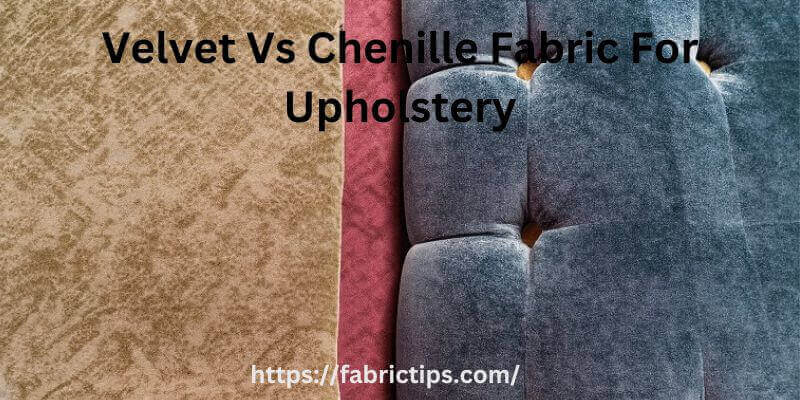
In terms of upholstery, velvet and chenille fabrics both have their benefits and disadvantages.
Chenille
Fabrics made from Chenille are known for their softness & plush texture, making them ideal for upholstery. However, velvet tends to be more durable than chenille, which is more susceptible to wear & tear. Additionally, Chenille fabric demands more maintenance because it snags and sheds more easily. Thus, chenille is best used in low-traffic areas or for items that are not heavily used, such as throw pillows or stylish accent chairs.
Velvet
Actually, Velvet fabrics are known for their luxurious appearance & durability. Compared to chenille, velvet is a heavier fabric that holds up better to wear & tear. In addition, velvet is easy to maintain & can be hand-washed or dry-cleaned. As a result, velvet is better suited to high-traffic areas and regularly used pieces, especially sofas and armchairs.
Overall, chenille and velvet fabrics will be selected according to individual preferences and needs. When comfort & softness are important, chenille is a better choice. Velvet may be a better option for those seeking durability and easy maintenance.
Chenille Vs Velvet – The Comparison
Texture & Feel Comparison
- Sensory Experience: Delve into how the plush, velvety texture of chenille offers a luxurious feel, drawing parallels and contrasts with the traditionally smooth and elegant finish of velvet. This section will emphasize the tactile differences central to the “Chenille Vs Velvet” discussion, appealing to readers interested in the sensory qualities of fabrics.
- Aesthetic Appeal: Highlight the visual differences between chenille and velvet. While both fabrics exude a sense of luxury, their textures contribute differently to the overall aesthetic, an important consideration in interior design and fashion.
Durability & Maintenance
- Longevity: Compare the durability of chenille and velvet, noting how each fabric withstands wear and tear. This part will address common concerns regarding the practicality of both fabrics in the “Chenille Vs Velvet” debate.
- Care Requirements: Offer detailed insights into the maintenance of both fabrics. While velvet might require more delicate handling, chenille is often praised for its ease of care, a crucial factor for consumers.
Suitability For Different Applications
- Versatile Uses: Discuss how chenille is favored in various applications such as upholstery, drapery, and clothing, and compare this with the traditional and modern uses of velvet. This comparison will shed light on the functional aspects that often come up in “Chenille Vs Velvet” discussions, particularly in interior design and fashion.
- Environmental Adaptability: Examine how each fabric performs in different environments, considering factors like climate and usage frequency.
Price Range & Affordability
- Cost-Effectiveness: Analyze the price range of chenille and velvet, offering a comparative perspective that adds another layer to the “Chenille Vs Velvet” discussion. This section will help readers understand the cost implications of choosing between these two luxurious fabrics.
- Value for Money: Discuss the value proposition of both chenille and velvet, considering their longevity, aesthetic appeal, and versatility.
Finally, concludes by summarizing the key points of comparison between chenille and velvet, guiding readers in making an informed choice based on texture, durability, application, and price.
Chenille Fabric: What Makes It Unique?

Chenille fabrics are unique because of their texture & manufacturing process. As a result, the fabric has a distinctive texture because of its fluffy pile. Pile materials include cotton, polyester, rayon, and acrylic, among others.
- Chenille fabrics are soft and warm, which is one of their benefits.
- Blankets, pillows, and other soft furnishings benefit from the fluffy pile’s cozy and comfortable feel.
- A versatile fabric choice, chenille fabrics come in a wide variety of styles, colors, and patterns.
- Additionally, chenille fabric is prone to snagging and shedding, making it harder to maintain compared to other fabrics.
- Their low durability makes them ideally suited to low-traffic areas as well.
- Chenille fabrics are popular for home decor applications due to their unique texture and softness.
However, this type of fabric requires a lot of maintenance.
Velvet Fabrics: What Makes It Unique?

Velvet fabric is distinguished by its luxurious finish and texture. In velvet, two layers of cloth are woven together before being cut into piles. As a result, the surface becomes dense and plush.
- In addition to their rich appearance, velvet fabrics also offer other advantages.
- It has a luxurious look and feel thanks to its depth and sheen.
- Furniture upholstery, home decor, and clothing items such as curtains & drapes often use this material.
- Fabrics made from velvet are also durable. Dense piles of the fabric make it withstand wear & tear, making it an ideal upholstery fabric.
- Aside from its ease of maintenance, velvet can easily be hand-washed or dry-cleaned.
- A variety of patterns and colors are also available in velvet fabrics, making them an ideal choice for any decorating style.
- There is a velvet fabric to fit every taste, from deep jewel tones to muted neutrals.
Generally, velvet fabrics’ unique appearance, durability, and texture qualify them as a top choice for the luxury home decor & fashion industry.
Chenille Vs Velvet – Choosing The Winner
Situational Recommendations
- Home Decor Context: Explore scenarios where the rich texture of chenille makes it a superior choice for certain home decor items like throw blankets and cushion covers, particularly in high-usage areas. Contrast this with the opulence and elegance of velvet, which might be more suitable for formal settings or decorative accents. This analysis provides practical insights into the “Chenille Vs Velvet” decision-making process.
- Fashion & Apparel: Discuss the suitability of chenille for casual, comfortable clothing, thanks to its softness and durability. In contrast, highlight how velvet often takes center stage in formal and evening wear, exuding luxury and sophistication.
Personal Preferences And Suitability
- Aesthetic & Feel: Delve into the subjective nature of fabric choice, emphasizing how personal preference for the feel and look of chenille or velvet plays a crucial role. This part of the “Chenille Vs Velvet” comparison acknowledges the individual tastes in texture, weight, and overall aesthetic.
- Lifestyle Considerations: Suggest considering lifestyle factors such as ease of maintenance, frequency of use, and environmental conditions when choosing between chenille and velvet. This helps readers align their fabric choice with their daily lives.
Overall Comparison And Verdict
- Texture and Comfort: Recap the differences in texture and comfort between chenille and velvet, highlighting how each fabric serves different tactile and aesthetic preferences.
- Durability and Care: Summarize the care requirements and durability of both fabrics, noting that chenille might be more forgiving in high-traffic situations compared to the more delicate velvet.
- Cost and Value: Briefly revisit the cost implications of choosing either fabric, considering both the initial investment and long-term maintenance costs.
Who is the winner? Conclude by stating that the choice between chenille and velvet ultimately depends on individual needs and preferences. While one fabric may excel in certain areas, the other might be more suitable in different contexts, making the “Chenille Vs Velvet” debate a matter of personal choice and specific requirements. This information allows readers to make an informed choice based on the detailed comparison, considering their unique needs and preferences.
Chenille Hats Vs Velvet Hats
| Comparison Properties | Chenille Hats | Velvet Hats |
| Uses: | Casual and Formal wear | Formal wear, Accessories with Dresses & Gowns, and Casual Wear. |
| Suitable For: | Unisex | Unisex |
| Advantages: | Perfect for winter wear, stylish appearance, easy to maintain | Perfect for winter wear, stylish appearance, easy to maintain |
| Disadvantages: | Expensive | Less warm in very cool climates |
| Durability: | Strong & long-lasting | Long-lasting and durable |
| Weight: | Relatively light | Relatively heavy |
| Waterproof Material: | Non-waterproof | Velvet is waterproof and very expensive |
| Reflective Material: | Not reflective | Slightly reflective |
| Weather: | Warm | Warm |
| Care & Maintenance: | Gentle hand wash only | Gentle hand wash only |
| Types & Styles: | Ribbed Beanie, Cuff Beanie, Pom Pom Beanie, Pull-On Hat, Floppy Hat, Snow Cap, Twist Cap | Captain’s Cap, Vintage hats & caps, Skull cap, Beret, Beanie, Slouchy beanie, Horse riding helmet, turban |
| Availability: | Easily Available | Easily Available |
| Prices: | $5 to $50 | $1 to $60 |
What Are The Differences Between Velvet And Chenille?
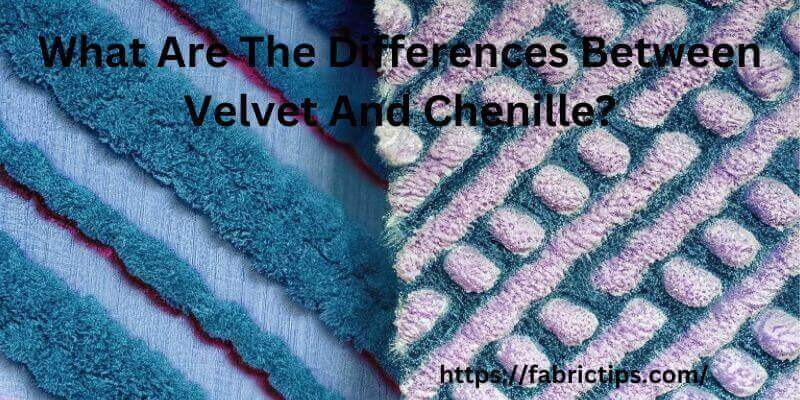
Velvet and Chenille fabrics are both luxurious and soft, but their texture and construction differ.
Chenille
- A chenille fabric consists of yarns made of cotton, rayon, or acrylic.
- An upholstered chair features a twisted or tufted pile made out of short lengths of yarn.
- After the pile has been trimmed, the surface is smooth and velvety.
- Chenille fabric is durable and strong, which makes it a popular fabric for upholstery and drapery.
Velvet
- On the other hand, velvet is made by weaving two layers of cloth together and adding a short, dense pile between them.
- By cutting the warp yarns, the long vertical threads running through the fabric, and brushing them, a pile is created.
- Velvet fabrics can be made from silk, cotton, or synthetic fibers, and they are known for their luxurious texture and sheen.
- In addition to upholstery, clothing, and accessories, velvet is commonly used in the fashion industry.
In summary, although both velvet and chenille fabrics are soft and plush, chenille is made of short tufted yarns that are woven and trimmed. Basically, velvet consists of two layers of cloth woven together with a dense pile between them.
FAQs
Q-1: What About Classic Velvet?
Answer: Most people are familiar with classic velvet fabrics.
- In classic velvet, the pile is smooth and soft, and its sheen is delicate.
- Due to its compactness and length, this fabric has the ridiculous softness you expect from velvet, as well as a delicate, cultured sheen.
- Elegant velvet slipcovers with a bold, fashionable look – perfect for bold, modern homes.
Q-2: What Is Comfort Chenille?
Answer: Introducing Comfort Chenille, our update to the classic chenille fabric.
- Chenille has a soft, plush texture, with a fluffy pile similar to caterpillars.
- This is the ultimate sofa fabric because of the way it’s made.
- Due to its unique composition, it can be worn throughout the year, regardless of what style you choose to wear it in.
Q-3: Which is More Durable, Chenille or Velvet?
Answer: Discuss the resilience of chenille, especially in high-traffic usage, and compare it to the more delicate nature of velvet. This response will clarify how each fabric stands up to wear and tear, a common query in the “Chenille Vs Velvet” discussion.
Q-4: How Do I Care for My Chenille and Velvet Fabrics?
Answer: Provide separate care instructions for each fabric, emphasizing the gentle cleaning needed for velvet and the slightly more robust approach suitable for chenille. This will help readers understand the maintenance needs, a crucial aspect of the “Chenille Vs Velvet” comparison.
Q-5: Can Chenille and Velvet Be Used for All Types of Furniture Upholstery?
Answer: Explain the suitability of chenille for everyday furniture due to its durability, and contrast it with velvet, which is often chosen for its luxurious appeal in less frequently used furniture. This distinction is important for readers considering either fabric for upholstery in the “Chenille Vs Velvet” context.
Q-6: Are Chenille and Velvet Suitable for People with Allergies?
Answer: Address the hypoallergenic properties of both fabrics, noting any differences and offering advice for allergy sufferers. This is a less common but relevant aspect of the “Chenille Vs Velvet” debate, especially for health-conscious consumers.
Q-7: Which Fabric is Better for Pet Owners, Chenille or Velvet?
Answer: Discuss the pet-friendliness of chenille, with its durability and ease of cleaning, in comparison to velvet, which may attract pet hair and require more delicate cleaning.
Q-8: How Does the Cost of Chenille Compare to Velvet?
Answer: Offer insights into the pricing of both fabrics, noting the factors that influence their cost. This helps in making a budget-conscious choice in the “Chenille Vs Velvet” decision.
Q-9: Can Chenille and Velvet Be Used in All Climates?
Answer: Describe how each fabric performs in different climates, with chenille being more adaptable to varied temperatures compared to velvet.
Q-10: What Are the Latest Trends in Chenille and Velvet Fabrics?
Answer: Share current trends in interior design and fashion for both chenille and velvet, giving readers an idea of how these fabrics are being used in contemporary settings.
Final Thoughts
Chenille Vs Velvet is compared based on their properties, looks, uses, texture, durability, maintenance, and more. Actually, along with being upholstery fabric, the Chenille fabric offers more options to women, but Velvet offers more options to everyone. The durability of Chenille exceeds that of velvet, even though velvet is a luxury furniture fabric. Soft and flexible, chenille fabric should give a good shine and, when touched, it should feel plush, cozy, and shiny. Chenille is thinner and softer than velvet, and velvet absorbs light better.
In this article, we discussed the differences and similarities between chenille and velvet fabrics. As well as their benefits, both have their drawbacks too. In general, Velvet & Chenille are each excellent in their own way. Finally, the choice is yours depending on your personal preferences, needs, and living situation.

